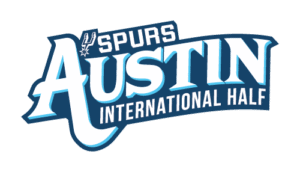First NBA Franchise to Hold Naming Rights to a Half Marathon
AUSTIN (Aug. 26, 2025) – Spurs Sports & Entertainment (SS&E) today announced a new partnership with the Austin International Half, becoming the official title sponsor of the race, which will now be known as the Spurs Austin International Half. The 2026 event is set for Sunday, January 18, 2026. This marks the first time an NBA team has secured naming rights to a half marathon.
As part of the multi-year agreement, Spurs branding will be integrated throughout race weekend, including signage, digital platforms and on-site activations. All registered runners will have access to purchase specialized ticket packages for San Antonio Spurs games. The Spurs will also create their own team for the race that participants can register for, which will include an exclusive Spurs item.
This partnership, which unites two longstanding local sports organizations, ties into the Spurs year-round engagement efforts in Austin, in addition to many other ongoing community initiatives like court renovations through PlayATX.
“This partnership represents another meaningful step in strengthening our bond with the Austin community,” said Brandon James, Senior Vice President of Strategic Growth and Deputy General Counsel for Spurs Sports & Entertainment. “From grassroots initiatives to bringing Spurs basketball to Austin through the I-35 Series, we’re committed to showing up in authentic and lasting ways. Aligning with one of the region’s premier running events not only deepens our presence in Central and South Texas, but also reinforces our dedication to health, wellness, and building community.”
“We couldn’t be more excited to partner with the Spurs,” said Jack Murray, Owner and Partnership Director of the Austin International Half. “They’ve shown time and again that their commitment to Austin goes far beyond basketball. Their values—teamwork, wellness, and uplifting the community—mirror everything this race stands for. Together, we’re creating something more than a race. We’re building an experience.”
The Spurs Austin International Half will feature its signature Downhill to Downtown™ course with a half marathon and two-person relay option. The fast, net-downhill 13.1-mile route winds through Austin neighborhoods and finishes in the heart of downtown. The event attracts runners from more than 47 states and 14 countries, with over 7,000 participants each year.
For registration and race details, visit AustinInternationalHalf.com. To take part in the event as part of the Spurs Fit Club Team, text SPURSFIT to 210-444-5940.
About Austin International Half
The Austin International Half, formerly the 3M Half Marathon, is one of Texas’ fastest and most exciting 13.1-mile events. Established in 1995, it features a net-downhill course that winds through Austin’s most iconic neighborhoods and finishes downtown. Runners enjoy a high-energy experience with live music, enthusiastic spectators, and top-tier course support. With PR potential, great swag, and an unbeatable Austin spirit, this event welcomes runners of all levels. Learn more at AustinInternationalHalf.com.
About Spurs Sports & Entertainment
Spurs Sports & Entertainment (SS&E) is a value-based and community-centric sports and entertainment company that provides premier live and global digital experiences for fans across a portfolio of three teams and several first-class venues in South Texas – all supported by a staff of more than 1,000 full and part-time employees. SS&E owns and operates the San Antonio Spurs (NBA), Austin Spurs (NBA G League), and San Antonio FC (USL), as well as manages the day-to-day operations of the Frost Bank Center, The Rock at La Cantera, Toyota Field and Ricos STAR Soccer Complex. The SS&E investor group is led by Managing Partner Peter J. Holt.

 Before Your Run: Prime Your Energy Tank
Before Your Run: Prime Your Energy Tank During Your Run: Keep the Fuel Flowing
During Your Run: Keep the Fuel Flowing After Your Run: Recover Like a Pro
After Your Run: Recover Like a Pro Whether you’re chasing that sub-2:00 milestone or simply want to feel stronger and more confident crossing the finish line, every second counts in a half marathon. And yes, even trimming just five seconds off your pace per mile can add up to a huge difference over 13.1 miles—think about it: that’s over a minute faster!
Whether you’re chasing that sub-2:00 milestone or simply want to feel stronger and more confident crossing the finish line, every second counts in a half marathon. And yes, even trimming just five seconds off your pace per mile can add up to a huge difference over 13.1 miles—think about it: that’s over a minute faster!